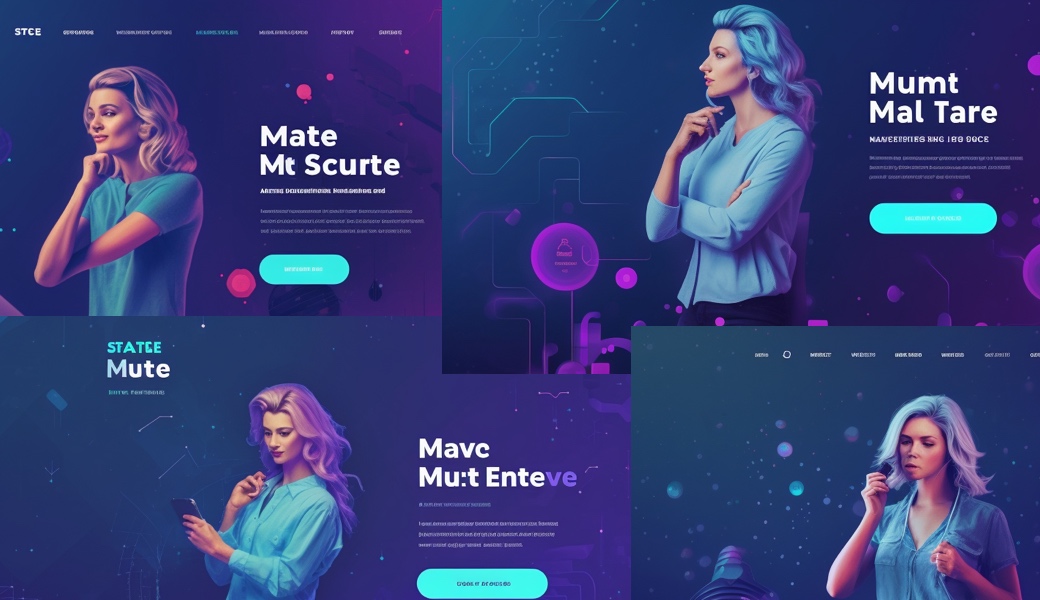
Noise in the competitive landscape is increasing at an alarming rate.
In 2022 alone, 5 million new businesses popped up in the US. This is a 78% increase compared to the 2.8 million added in 2015.
The thing is, noise isn’t evenly distributed across the competitive landscape. Instead, you can think of it more like a bell shaped curve.
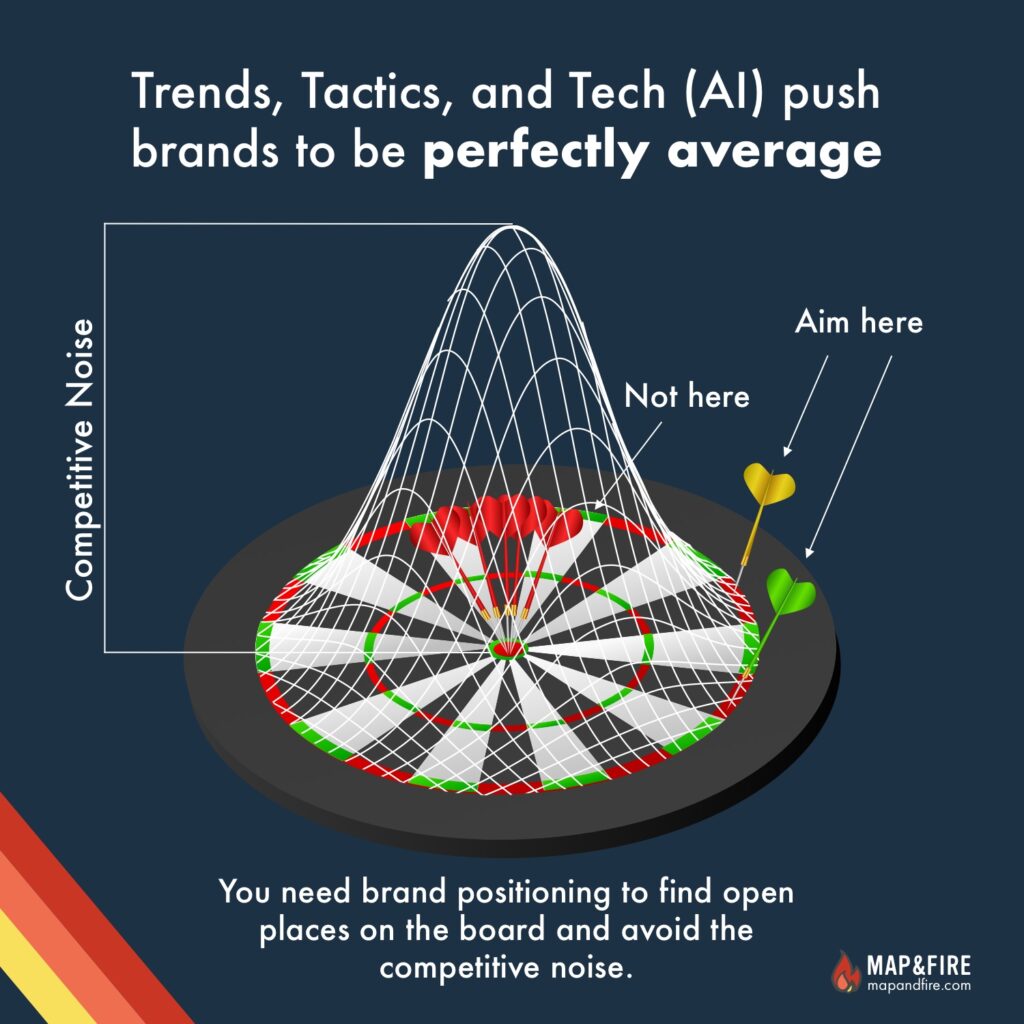
With a bell curve, the edges represent the most differentiated brands. This is where brands can thrive because competitive noise is low.
As you move toward the center of the curve, that volume steadily increases until you reach the deafening center of the perfectly average.
There are lots of things that contribute to the perfectly average center of the bell curve:
- When something works in the marketplace – a business idea, marketing tactic, product feature – brands see that and work to copy it
- Modern digital tools make certain trends and best practices easier and more efficient to access and implement (e.g. Shopify helping to churn out templatized ecommerce websites)
- There’s of course the natural fear of being too different that pushes brands to play it safe
- And now there’s AI, which is the ultimate amplifier of becoming perfectly average
AI alone may surpass all these other factors when it comes to propping up the peak of the competitive bell curve.
Generative AI tools can now help businesses of all sizes with tasks ranging from copywriting, to visual design, to full on ad creation.
But the catch is the type of content that AI generates.
Tools like Chat-GPT get trained on billions of pieces of writing and language data that exist in the world. When you ask it a question it attempts to construct a reasonable response based on all that pre-existing material.
Generative AI builds written responses word-by-word. it starts with one word then looks at a range of probabilities around what the next most likely word should be and adds it to the response.
In short, this is how the system delivers a perfectly average response to your question.
It’s important to note some things about those perfectly average responses:
- They do not need to be engaging, insightful, or in some cases even factually correct
- They do not include an expert fact checker
- And they definitely don’t aim to create a unique point of view for your brand
Generative AI doesn’t “know” what it’s telling you. Its job is to spit out content based on math and code.
But the fact that those responses come very fast and very cheap make them very enticing.
And when millions of new and existing businesses take advantage of these tools it’s easy to see how it can create a tidal wave shape around this specific type of noise.

For brands that lean heavily on AI (along with all those other pre-existing factors) being visible, remembered, and sparking growth becomes nearly impossible.
This is what makes brand positioning strategy the most important thing for a brand to invest in.
It’s not a nice-to-have. It’s literally the only way a brand can diverge from the curve.
Quick Case Study of Noise Level: Martech
To help bring this idea of competitive noise to life, look no further than the world of martech.
The martech category focuses on software that teams use to run and manage their marketing efforts. According to Martechmap there are now over 11,000 products aimed at helping brands market themselves more effectively.

Now that’s loud.
This is the ultimate signal of noise for two reasons:
- It shows how many brands can exist and compete within a single, larger category
- Martech creates products that businesses across every category need – i.e. martech can’t thrive without a massive macro-need to help brands connect with their customers
As mentioned, brands are already skilled at leveraging trends and blending in with the competition.
Here’s a snapshot of SaaS brand home pages that all lean on a similar trend to help convey the benefits of their product.

And here’s what happens when we ask a generative AI tool (in this case, Midjourney) to create a “Website homepage design for a new marketing SaaS product”:
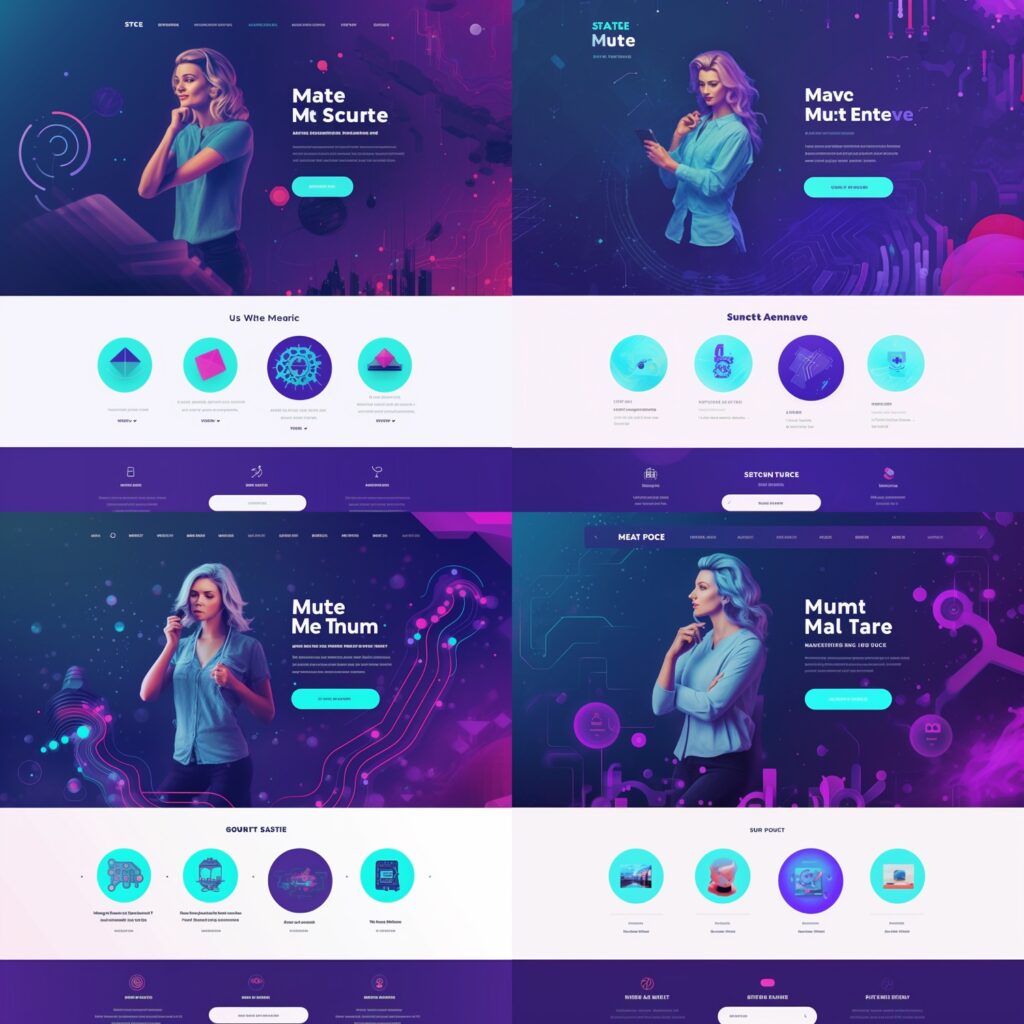
If you ignore the strange faces, arms, and hands the patterns are clear.
This helps articulate the relationship of generative AI with the real world inputs it consumes – and the cycle it creates:
- Brands identify and perpetuate patterns (see the reasons above for this)
- AI systems consume pattern-heavy inputs which skews the probability of generating content similar to these patterns
- Brands use the pattern-fed content created by generative AI
- The cycle continues
- The volume of perfectly average noise goes up, and up, and up…
It’s sort of an ouroboros type situation where the snake eats its own tail but only gets bigger, stronger, and hungrier as it goes.
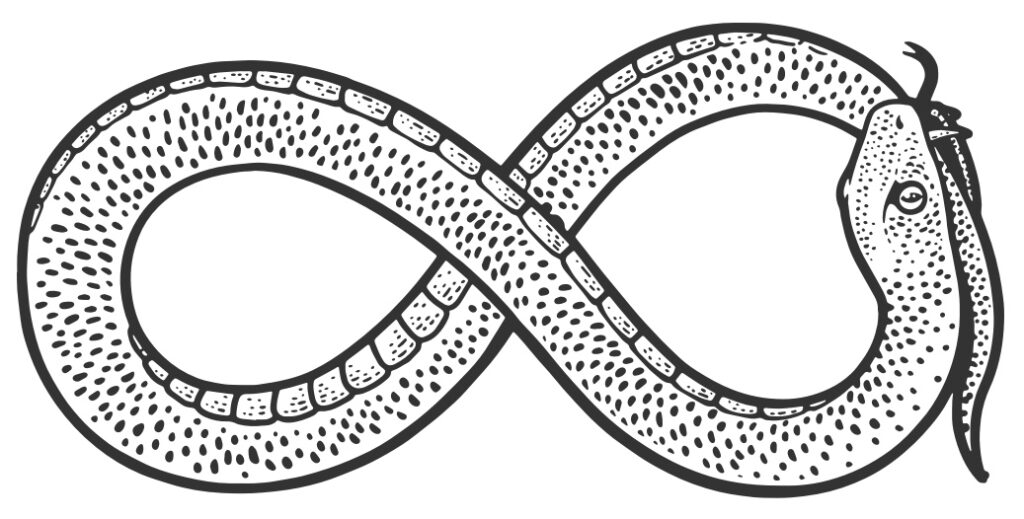
The above example focuses on design patterns but the same issues exist with any area where brands might leverage best practices trends plus generative AI.
The end result impacts everything from value propositions, to messaging, to content. All the key expressions of your brand’s value.
This is why we come back to the need to create a strong brand positioning strategy.
How To Escape The Perfectly Average Cycle
To avoid getting lost in the pattern-matching noise of perfectly average brands, you have to do the opposite – differentiate.
This is at the heart of why we use brand positioning strategy.
Your brand positioning centers on defining and communicating what makes your brand unique within your category.
When your positioning is crystal clear you help customers:
- Discover: Create space around your brand so it stands out
- Understand: When someone engages with your brand they “get” the value
- Remember: The combination of value you provide and the way you present it allows your brand to occupy a unique place in your customer’s mind
- Embrace: Because your brand offers something unique customers have a reason to choose that value and share it with others
To achieve that difference though, your brand needs to violate the customer’s expectations.
This is how you avoid landing on the noisy bullseye of the perfectly average.
Your customers come to you with a certain set of expectations. They have a particular job they’re seeking to satisfy. They have different factors they value in a solution.
Based on their expectations and past experiences they form an abstract idea of what they might need.
This creates a mental model of an average solution.
The trap that many brands fall into is that they try to deliver on that average solution image.
When you use that strategy to compete against lots of brands – say 11,000 in one category – you get reduced to a needle in a haystack.
Brand positioning does the opposite. It creates the foundation for differentiation through 3 key areas:
1) Customers
Key question:
What do our customers seek to accomplish and what do they value in a potential solution?
How to answer this:
- Research: Use surveys and interviews to gain a deep understanding of what drives customer behaviors
- Jobs to Be Done: Focus on understanding what motivates customers and what outcomes they seek. Center on what your customers need rather than just what your brand provides.
- Elements of Value: Break down the specific points of value that your customers care about across functional, emotional, and aspirational tiers.
2) Competition
Key question:
Where does our brand deliver value at a high level that diverges from what our competitors provide?
How to answer this:
- Research: Learn how our customers view the competitive landscape and what types of solutions they consider. Look at both direct, head-to-head competitors and indirect competitors that satisfy those needs in a different way.
- Rating Your Value: Use the Elements of Value to rate how well your brand delivers on those points compared to both direct and indirect competitors.
- Strategy Canvas: Map the ratings for your brand versus competitors to see where your brand delivers the most differentiated levels of value.
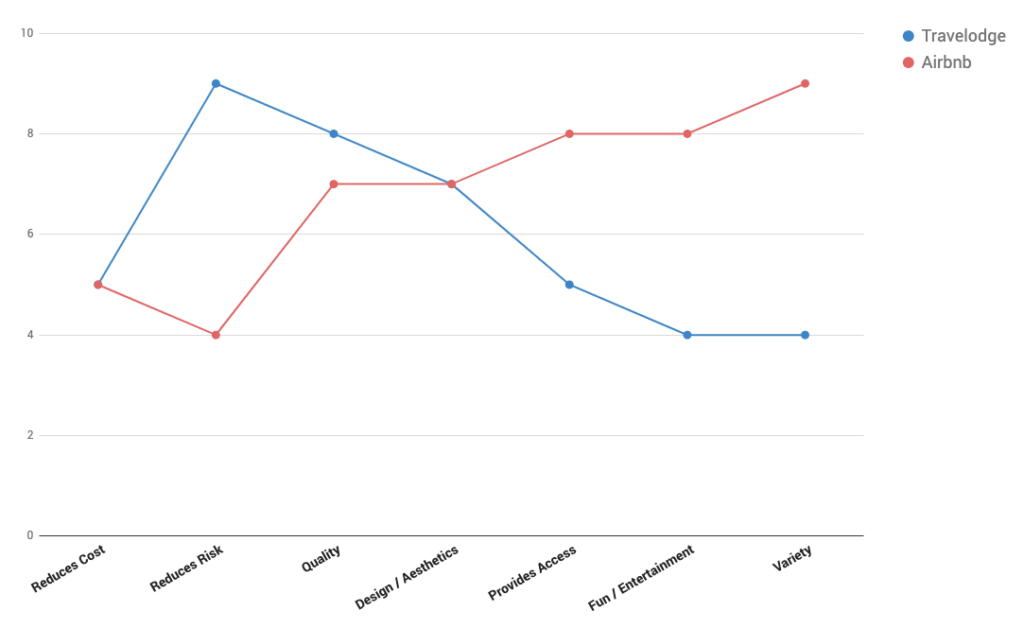
3) Offering
Key question:
How well do our brand’s solutions align with the needs of our customers?
How to answer this:
- Research: You may see a trend here! Validate whether the products and services that our brand provides meet the needs of customers.
- Feature Mapping: Map the most important features of an offering back to the Elements of Value to see where alignment exists and where there may be opportunities to improve.
- Features to Benefits: Start to create language around how our offering improves the lives of customers. Build the bridge from brand positioning to marketing.
Together, these pieces create a living, breathing map for how your brand differentiates itself.
It allows you to see where your brand stands today and provides tools to evolve as the competitive landscape shifts and your brand grows.
How Your Brand Can Thrive Within An AI-World
The advancement of technology is inevitable. Generative AI isn’t going to pause and wait for your brand to figure things out. If anything it’s a trend that’s likely to accelerate at a pace none of us can fully grasp right now.
And AI isn’t a bad thing!
While the focus here has been on how to survive AI’s noise, you can also use AI to elevate strategic work.
As the technology evolves we can look for ways to use AI to help research markets and effectively and explore opportunities for differentiation.
The key is that we understand what AI’s strengths and weaknesses are – and recognize the impact of those strengths and weaknesses on the landscape.
Lots of brands will get seduced by the promise of efficiencies and ignore the potential trappings.
Brands that take a critical view of technology and trends, understand the limitations, and continue to lean on human-driven brand positioning strategy and research can thrive even as the noise gets jet-engine loud.

Get help with your brand positioning
If you’re ready to build stronger connections with your customers, reach out for a free consultation. We’ll help you transform your best business thinking into an actionable, shareable, growth-oriented guide. Click below to learn more about the Brand Guidebook process.

